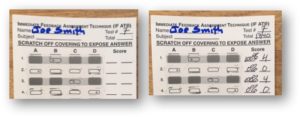By Aaron S. Richmond, Ph. D., Metropolitan State University of Denver
When prepping my courses for this spring semester, I was thinking about how I often struggle with providing quick and easy feedback on quiz and exam performance to my students. I expressed this to my colleague, Dr. Anna Ropp (@AnnaRopp), and she quickly suggested that I check out Immediate Feedback Assessment Technique (IF-AT) by Epstein Educational Enterprises. When she showed me the IF-ATs, I was intrigued and thought I might as  well give it a try—so I ordered some. IF-AT is used to instantaneously provide performance feedback to learners by allowing students to scratch off what they believe to be the correct answer on a multiple-choice exam, quiz or test. See Figure 1a and 1b for student examples of a completed IF-AT. Students can find out what the incorrect or correct answer is by just scratching the chosen answer (see question 1 in Figure 1a). Students can scratch more than one answer to find the correct answer (see question 2 in Figure 1a). You may also use it as a way of providing partial credit for sequenced attempts (e.g., scratch 1 choice for full credit if correct, then scratch a second choice, and maybe a third, to get decreasing amounts of partial credit). See question 6 in Figure 1b for an example of this. Epstein and colleagues suggest that IF-AT not only assesses student learning, but it can also teach at the same time. However, it occurred to me that this is not only an assessment and teaching tool, rather it is a great opportunity to increase metacognition.
well give it a try—so I ordered some. IF-AT is used to instantaneously provide performance feedback to learners by allowing students to scratch off what they believe to be the correct answer on a multiple-choice exam, quiz or test. See Figure 1a and 1b for student examples of a completed IF-AT. Students can find out what the incorrect or correct answer is by just scratching the chosen answer (see question 1 in Figure 1a). Students can scratch more than one answer to find the correct answer (see question 2 in Figure 1a). You may also use it as a way of providing partial credit for sequenced attempts (e.g., scratch 1 choice for full credit if correct, then scratch a second choice, and maybe a third, to get decreasing amounts of partial credit). See question 6 in Figure 1b for an example of this. Epstein and colleagues suggest that IF-AT not only assesses student learning, but it can also teach at the same time. However, it occurred to me that this is not only an assessment and teaching tool, rather it is a great opportunity to increase metacognition.
(a) (b)
Figure 1. Completed and Unscored 10-Question IF AT Completed 10-Question IF AT Student and Teacher Scored
How to Use IF-AT
Epstein and colleagues suggest that IF-AT is fair, fast, active, fun, and respectful and builds knowledge. The IF-AT scratch assessments come in 10, 25, or 50-item test options with 5 different orders of correct answers. The Epsteins suggest that IF-AT can be used in many ways. For example, they can be used for chapter tests; individual study (at home or in class); quizzes; pyramidal-sequential-process quizzing; exams; team-based and cooperative-learning; study-buddy learning; and most importantly as a feedback mechanism (see http://www.epsteineducation.com/home/about/uses.aspx website for further explanation). There are several metacognitive functions (although the Epstein’s do not couch their claims using this term) of the IF-AT. First, the Epstein’s argue that you can arrange your IF-AT so that the first question (and the immediate feedback of the correct answer) can be used in a pyramidal sequential process. That is, the correct answer to the first question is needed to answer subsequent questions as it is foundational knowledge for the remaining question. This sequential process allows the instructor and student to pin-point where the student’s knowledge of the integrated content broke down. This is implicit metacognitive modeling of a student’s metacognitive knowledge that should be made explicit. Meaning, by explaining to your students how the exam is set up, students can use cues and knowledge from previous questions and answers on the test to assist in their understanding of subsequent questions and answers. This is a key step to the learning process. Second, the IF-AT may also be used in a Team-Based way (i.e., distributed cognition) by forming groups, problem solving, and the team discovering what the correct answer is. IF-AT may also be used in dyads to allow students to discuss correct and incorrect answers. Students read a question, discuss the correct and incorrect answer, then cooperatively make a decision and receive immediate feedback. Third, IF-AT may be used to increase cognitive and metacognitive strategies. That is, by providing feedback immediately, students (if you explicitly instruct them to do so) may adjust their cognitive and metacognitive strategies for future study. For example, if a student used flashcards to study, and did poorly, they may want to adjust how they construct and use flashcards (e.g., distributed practice). Finally, and most importantly, IF-AT may improve student’s metacognitive regulation via calibration (i.e., the accuracy of knowing when you do and don’t know the answer to a question). That is, by providing immediate feedback, students may become more accurate in their judgments of knowing or even their feelings of knowing based on the feedback.
Is it Scratch to Win or is Scratch to Lose?
 As described, by using the IF-AT, students get immediate feedback on whether they got the question correct, incorrect, and what is the appropriate answer. From a metacognitive perspective, this is outstanding. Students can calibrate (i.e., adjust their estimations and confidence in knowing an answer) in real-time, engage in distributed cognition, provide feedback on choice of cognitive and metacognitive strategies, can increase cognitive monitoring, and regulation control. These are all WIN, WIN, WIN, byproducts. HOWEVER, is there a down-side to instantaneously knowing you are wrong? That is, is there an emotional regulation and reactivity to IF-AT? As I have been implementing the use of the IF-AT, I have noticed (anecdotally) that about 1 in 10 students react negatively and it seems to increase their test anxiety. Presumably, the other 90% of the students love it and appreciate the feedback. Yet, what about the 10%? Does IF-AT stunt or hinder their performance? Again, my esteemed colleague Dr. Anna Ropp and I engaged in some scholarly discourse to answer this question, and Anna suggested that I make the first 3-5 questions on each IF-AT “soft-ball” questions. That is, questions that 75% of students will get correctly so that students’ fears and anxiety is remediated to some degree. Another alternative is to provide students with a copy of the test or exam and let them rank order or weight their answers (see Chris Was’ IwM Blog, 2014; on how to do this). Despite these two sound suggestions, there still may be an affective reaction that could be detrimental to student learning. To date, there has been no research to investigate this issue and there are only a hand full of well-designed studies to investigate IF-AT (e.g., Brosvic et al., 2006; Dihov et al., 2005; Epstein et al., 2002, 2003; Slepkov & Sheill, 2014). As such, more well-constructed and executed empirical research is needed to investigate this issue (Hint: all you scholars looking for a SoTL project…here’s your sign).
As described, by using the IF-AT, students get immediate feedback on whether they got the question correct, incorrect, and what is the appropriate answer. From a metacognitive perspective, this is outstanding. Students can calibrate (i.e., adjust their estimations and confidence in knowing an answer) in real-time, engage in distributed cognition, provide feedback on choice of cognitive and metacognitive strategies, can increase cognitive monitoring, and regulation control. These are all WIN, WIN, WIN, byproducts. HOWEVER, is there a down-side to instantaneously knowing you are wrong? That is, is there an emotional regulation and reactivity to IF-AT? As I have been implementing the use of the IF-AT, I have noticed (anecdotally) that about 1 in 10 students react negatively and it seems to increase their test anxiety. Presumably, the other 90% of the students love it and appreciate the feedback. Yet, what about the 10%? Does IF-AT stunt or hinder their performance? Again, my esteemed colleague Dr. Anna Ropp and I engaged in some scholarly discourse to answer this question, and Anna suggested that I make the first 3-5 questions on each IF-AT “soft-ball” questions. That is, questions that 75% of students will get correctly so that students’ fears and anxiety is remediated to some degree. Another alternative is to provide students with a copy of the test or exam and let them rank order or weight their answers (see Chris Was’ IwM Blog, 2014; on how to do this). Despite these two sound suggestions, there still may be an affective reaction that could be detrimental to student learning. To date, there has been no research to investigate this issue and there are only a hand full of well-designed studies to investigate IF-AT (e.g., Brosvic et al., 2006; Dihov et al., 2005; Epstein et al., 2002, 2003; Slepkov & Sheill, 2014). As such, more well-constructed and executed empirical research is needed to investigate this issue (Hint: all you scholars looking for a SoTL project…here’s your sign).
Concluding Thoughts and Questions for You
After investigating, reflecting on, and using IF-AT in my classroom, I think that it is a valuable assessment tool in your quiver of assessments to increase metacognition—but of course not an educational panacea. Furthermore, in my investigation of this assessment technique, (as usual), more questions popped up on the use of IF-AT. So, I will leave you with a charge and call to help me answer the questions below:
- Are there similar assessments that provide immediate feedback that you use? If so, are they less expensive or free?
- If you are using IF-AT, what is your favorite way to use it?
- Do you think IF-AT could cause substantial test anxiety? If so, to whom and to what level within your classes?
- How could you use IF-AT be used as a tool for calibration more efficiently? Or, what other ways do you think IF-AT can be used to increase metacognition?
- I think there are enormous opportunities for SoTL on IF-AT (e.g., the effects on calibration, distributed cognition, cognitive monitoring, conditional knowledge of strategy use, etc.), which means we all have some more work to do. J
References
Brosvic, G. M., Epstein, M. L., Dihoff, R. E., & Cook, M. J. (2006). Acquisition and retention of Esperanto: The case for error correction and immediate feedback. The Psychological Record, 56(2), 205.
Dihoff, R. E., Brosvic, G. M., Epstein, M. L., & Cook, M. J. (2005). Adjunctive role for immediate feedback in the acquisition and retention of mathematical fact series by elementary school students classified with mild mental retardation. The Psychological Record, 55(1), 39.
Epstein, M. L., Brosvic, G. M., Costner, K. L., Dihoff, R. E., & Lazarus, A. D. (2003). Effectiveness of feedback during the testing of preschool children, elementary school children, and adolescents with developmental delays. The Psychological Record, 53(2), 177.
Epstein, M. L., Lazarus, A. D., Calvano, T. B., & Matthews, K. A. (2002). Immediate feedback assessment technique promotes learning and corrects inaccurate first responses. The Psychological Record, 52(2), 187.
Slepkov, A. D., & Shiell, R. C. (2014). Comparison of integrated testlet and constructed-response question formats. Physical Review Special Topics-Physics Education Research, 10(2), 020120.
Was, C. (2014, August). Testing improves knowledge monitoring. Improve with Metacognition. Retrieved from https://www.improvewithmetacognition.com/testing-improves-knowledge-monitoring/
